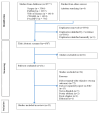Healthcare Service Utilisation Across Continuum of Care for Type 2 Diabetes Among Culturally and Linguistically Diverse Populations: A Systematic Review
- PMID: 40869864
- PMCID: PMC12386074
- DOI: 10.3390/ijerph22081279
Healthcare Service Utilisation Across Continuum of Care for Type 2 Diabetes Among Culturally and Linguistically Diverse Populations: A Systematic Review
Abstract
Introduction: Healthcare service utilisation for type 2 diabetes (T2D) is suboptimal among people from culturally and linguistically diverse (CALD) backgrounds. Synthesised evidence on drivers influencing their healthcare access and utilisation across the continuum of care (CoC) is scarce. This review synthesised drivers of accessing and utilising healthcare services across the CoC for T2D from the perspectives of people from CALD backgrounds and their healthcare service providers (HSPs). Methods: Five databases (Scopus, PubMed, Web of Science, CINAHL, and PsycINFO) were searched from inception to November 2023. This review was prospectively registered with PROSPERO (ID: CRD42023491560). The McGill Mixed Methods Appraisal Tool (MMAT) was used to assess the quality of articles included in this systematic review. Studies were included if they were primary research involving people from CALD backgrounds and/or their HSPs, and reported data related to access to and utilisation of services across the CoC. The CoC framework was used to conduct a guided thematic analysis for qualitative findings and narrative synthesis was used to summarise quantitative findings. Results: Thirty-five studies were included: 31 qualitative, 3 quantitative, and 1 mixed-method. Psychosocial (e.g., fear of treatment) and sociocultural barriers (e.g., stigma) were reportedly encountered at diagnosis and initiation of treatment. Language and cultural barriers were expressed by most people with T2D and their HSPs, especially at the monitoring and adherence stages of the CoC. Trusted relationships with HSPs and the cultural competency of the HSPs were facilitators of continued monitoring and adherence and long-term care and management. No barriers or facilitators were identified for decision-making to enter the healthcare systems, screening, and first point of contact aspects of the CoC from the perspectives of either patients or HSPs. Conclusions: Although included articles were heavily skewed towards qualitative studies, the synthesised evidence on factors influencing access to and utilisation of healthcare services for T2D can inform policymaking by highlighting pathways to improved use of healthcare services among these groups.
Keywords: continuum of care; culturally and linguistically diverse; healthcare service utilisation; type 2 diabetes.
Conflict of interest statement
The authors declare no conflicts of interest.
Figures
Similar articles
-
Cultural competence education for health professionals.Cochrane Database Syst Rev. 2014 May 5;2014(5):CD009405. doi: 10.1002/14651858.CD009405.pub2. Cochrane Database Syst Rev. 2014. PMID: 24793445 Free PMC article.
-
Prescription of Controlled Substances: Benefits and Risks.2025 Jul 6. In: StatPearls [Internet]. Treasure Island (FL): StatPearls Publishing; 2025 Jan–. 2025 Jul 6. In: StatPearls [Internet]. Treasure Island (FL): StatPearls Publishing; 2025 Jan–. PMID: 30726003 Free Books & Documents.
-
Strategies to promote the completion of patient-reported outcome measures by culturally and linguistically diverse and Indigenous Peoples in clinical care settings: A systematic review.Qual Life Res. 2025 Jun;34(6):1541-1551. doi: 10.1007/s11136-025-03913-2. Epub 2025 Feb 8. Qual Life Res. 2025. PMID: 39921825 Free PMC article.
-
An interpretive phenomenological analysis of the experiences of disability service providers supporting people from culturally and linguistically diverse backgrounds, and how these are shaped by disability policy within Australia.Aust Occup Ther J. 2025 Aug;72(4):e70038. doi: 10.1111/1440-1630.70038. Aust Occup Ther J. 2025. PMID: 40624824 Free PMC article.
-
Survivor, family and professional experiences of psychosocial interventions for sexual abuse and violence: a qualitative evidence synthesis.Cochrane Database Syst Rev. 2022 Oct 4;10(10):CD013648. doi: 10.1002/14651858.CD013648.pub2. Cochrane Database Syst Rev. 2022. PMID: 36194890 Free PMC article.
References
-
- IDF Facts and Figures: International Diabetes Federation. 2024. [(accessed on 10 January 2025)]. Available online: https://idf.org/about-diabetes/diabetes-facts-figures/
-
- Ong K.L., Stafford L.K., McLaughlin S.A., Boyko E.J., Vollset S.E., Smith A.E., Dalton B.E., Duprey J., Cruz J.A., Hagins H., et al. Global, regional, and national burden of diabetes from 1990 to 2021, with projections of prevalence to 2050: A systematic analysis for the Global Burden of Disease Study 2021. Lancet. 2023;402:203–234. doi: 10.1016/S0140-6736(23)01301-6. - DOI - PMC - PubMed
-
- Pham T.T.L., Berecki-Gisolf J., Clapperton A., O’Brien K.S., Liu S., Gibson K. Definitions of culturally and linguistically diverse (CALD): A literature review of epidemiological research in Australia. Int. J. Environ. Res. Public Health. 2021;18:737. doi: 10.3390/ijerph18020737. - DOI - PMC - PubMed
Publication types
MeSH terms
LinkOut - more resources
Full Text Sources
Medical



